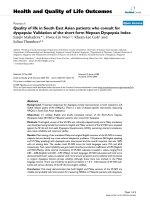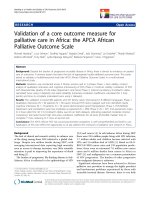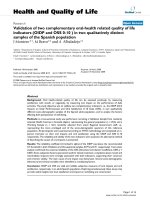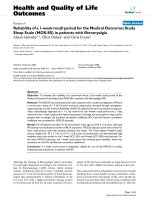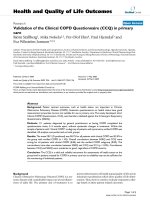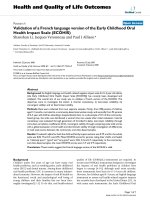báo cáo hóa học:" Validation of the Self-Management Ability Scale (SMAS) and development and validation of a shorter scale (SMAS-S) among older patients shortly after hospitalisation" doc
Bạn đang xem bản rút gọn của tài liệu. Xem và tải ngay bản đầy đủ của tài liệu tại đây (180.11 KB, 24 trang )
This Provisional PDF corresponds to the article as it appeared upon acceptance. Fully formatted
PDF and full text (HTML) versions will be made available soon.
Validation of the Self-Management Ability Scale (SMAS) and development and
validation of a shorter scale (SMAS-S) among older patients shortly after
hospitalisation
Health and Quality of Life Outcomes 2012, 10:9 doi:10.1186/1477-7525-10-9
Jane M Cramm ()
Mathilde MH Strating ()
Paul L de Vreede ()
Nardi Steverink ()
Anna P Nieboer ()
ISSN 1477-7525
Article type Research
Submission date 29 September 2011
Acceptance date 24 January 2012
Publication date 24 January 2012
Article URL />This peer-reviewed article was published immediately upon acceptance. It can be downloaded,
printed and distributed freely for any purposes (see copyright notice below).
Articles in HQLO are listed in PubMed and archived at PubMed Central.
For information about publishing your research in HQLO or any BioMed Central journal, go to
/>For information about other BioMed Central publications go to
/>Health and Quality of Life
Outcomes
© 2012 Cramm et al. ; licensee BioMed Central Ltd.
This is an open access article distributed under the terms of the Creative Commons Attribution License ( />which permits unrestricted use, distribution, and reproduction in any medium, provided the original work is properly cited.
Validation of the Self-Management Ability Scale (SMAS) and
development and validation of a shorter scale (SMAS-S) among older patients
shortly after hospitalisation
Jane M. Cramm
*
, Mathilde M. H. Strating
*
, Paul L de Vreede
†
, Nardi Steverink
‡
, Anna P.
Nieboer
*
*
Institute of Health Policy & Management (iBMG), Erasmus University, Rotterdam, The
Netherlands
†
Erasmus MC, Department of Public Health, Rotterdam, the Netherlands
‡
Section Health Psychology, Department of Health Sciences, University Medical Center
Groningen, University of Groningen
JC:
MS:
PV:
NS:
AN:
Corresponding author:
A.P. Nieboer
Erasmus University Rotterdam (iBMG)
Burgemeester Oudlaan 50
3000 DR Rotterdam
T +31-10-408 2804
F +31-10-408 9094
E
2
ABSTRACT
BACKGROUND. The 30-item Self-Management Ability Scale (SMAS) measures self-
management abilities (SMA). Objectives of this study were to (1) validate the SMAS among
older people shortly after hospitalisation and (2) shorten the SMAS while maintaining adequate
validity and reliability.
METHODS. Our study was conducted among older individuals (>65) who had recently been
discharged from a hospital. Three months after hospital admission, 296/456 patients (65%
response) were interviewed in their homes. We tested the instrument by means of structural
equation modelling, and examined its validity and reliability. In addition, we tested internal
consistency of the SMAS and SMAS-S among a study sample of patients at risk for
cardiovascular diseases.
RESULTS. After eliminating 12 items, the confirmatory factor analyses revealed good indices of
fit with the resulting 18-item SMAS (SMAS-S). To estimate construct validity of the instrument,
we looked at correlations between SMAS subscale scores and overall well-being scores as
measured by Social Product Function (SPF-IL) and Cantril’s ladder. All SMAS subscales of the
original and short version significantly correlated with SPF-IL scores (all at p ≤ 0.001) and
Cantril’s ladder (for the cognitive well-being subscale p ≤ 0.01; all other subscales at p ≤ 0.001).
The findings indicated validity. Analyses of the SMAS and SMAS-S in the sample of patients at
risk for cardiovascular diseases showed that both instruments are reliable.
CONCLUSIONS. The psychometric properties of both the SMAS and SMAS-S are good. The
SMAS-S is a promising alternate instrument to evaluate self-management abilities.
3
BACKGROUND
Besides a growing population of older people, a greater proportion live alone and sociological
changes have forced them to rely more often on their own resources [1]. They are also
hospitalised with increasing frequency as the risk for (multiple) chronic diseases increases with
age [3]. They often experience losses in various domains of functioning, which leads to frailty,
especially after hospitalisation [2]. Accurately assessing how they manage their well-being is
thus critical.
Successful aging requires the proactive management of resources in an environment of
increasing losses and declining gains [2], and depends on individuals’ abilities to self-manage
their lives and aging processes. Although such self-regulation is often related primarily to aspects
of physical health, such as physical activity and diet [4-6], the social and psychological aspects
of life – social contacts, adaptation, well-being – are equally important to older peoples’ ability
to ‘age well’ [7]. Despite acknowledgement of the importance of individuals’ contributions to
aging successfully and the existence of psychosocial theories of successful aging [2,8-12],
relatively few suggestions have been made to help older people self-regulate and maintain their
well-being [13].
The self-management of well-being (SMW) theory [13], based on the theory of social
production functions (SPF) [14,15], offers guidelines for achieving better self-regulation with
regard to well-being. SMW theory posits that successful aging is a life-long process of realizing
and sustaining well-being, even in the face of declining resources. Rather than being the process
of neutralising losses and discrepancies, successful aging focuses on individuals’ reserve
capacities to realize and sustain physical and social well-being using external and internal
resources [13]. External resources contribute directly to aspects of well-being, such as food,
4
shelter, fitness (physical well-being) and friends (social well-being). They tend to decline with
age. Self-management abilities (internal resources) are needed to manage external resources in
such a way that physical and social well-being are maintained or restored when lost [16]. SMW
theory incorporates six core abilities to form the composite construct of self-management: (1)
take initiatives (be instrumental or self-motivating in realizing aspects of well-being); (2) invest
in resources for long-term benefits; (3) maintain variety in resources (achieve and maintain
various resources for each dimension of well-being); (4) ensure resource multifunctionality (gain
and maintain resources or activities that serve multiple dimensions of well-being simultaneously
and in a mutually reinforcing way); (5) self-efficaciously manage resources (gain and maintain a
belief in personal competence to achieve well-being); and (6) maintain a positive frame of mind.
Each of these abilities must be related explicitly to the dimensions of well-being specified in the
SPF theory: physical well-being (comfort and stimulation) and social well-being (affection,
behavioural confirmation, and status) [13-15,17,18].
The 30-item Self-Management Ability Scale (SMAS) was developed to measure SMA
[19]. Losses in functioning – something that is especially associated with hospitalisation – lead
to a decreased reserve capacity for coping with losses. Self-management abilities become
particularly important. Our first objective was to validate the SMAS among older people shortly
after hospitalisation. The six subscales of the SMAS reflect the six SMA core abilities.
Schuurmans and colleagues [19] concluded that future research could focus on shorter forms of
the scale because (i) high correlations were found between some subscales and (ii) some items
seemed to be less indicative of SMA (lower loadings). Our second objective was thus to reduce
the number of items in the SMAS while maintaining validity and reliability.
5
METHODS
Study 1
Our study was conducted in 2010 among older people who had recently been admitted to a
hospital in the context of the ‘Prevention and Reactivation Care Programme’, which was
designed to prevent loss of function in older patients due to hospitalisation and targeted older
hospital patients (>65 years of age) who were vulnerable to loss of function after hospital
admission. Three months after hospital admission is known to be a good moment to assess
effects of a programme [20,21]. Therefore, patients were interviewed three months after hospital
admission. Our research is based on the pilot study of 456 patients (>65 years old) prior to
implementation of the ‘Prevention and Reactivation Care Programme’. The results of the pilot
study have been used to identify possible practical implementation problems in preparation for
the main evaluation study and serve as a base for power calculations for the main study. We
interviewed 296 patients in their homes (response rate 65%). This work was supported by
Netherlands organisation for health research and development (ZonMw) grant number: 60-
61900-98-130.
Ethical approval
The study protocol was approved by the medical ethics committee of the Erasmus Medical
Centre, Rotterdam, the Netherlands, under protocol number MEC2011-041.
Measures
The 30-item SMAS consists of six five-item subscales. The scale’s overall internal consistency is
0.90 [19]. Within the subscales of taking initiative, investing, self-efficacy, variety, and
6
multifunctionality, abilities are related to the physical and social dimensions of well-being in the
SPF theory [13,14]. The ability to have a positive frame of mind is considered a more general
cognitive frame; its subscale is thus not directly related to specific dimensions of well-being.
Average overall SMAS scores range from 5 to 30, with higher scores indicating higher SMA.
Overall subjective well-being was measured with the SPF-IL(s) (15-item Social Production
Function Instrument for the Level of well-being) [17]. The scale integrates both affective and
cognitive components of well-being, and measures levels of physical and social well-being.
Cronbach’s alpha of the SPF-IL in our study was 0.72, indicating a reliable instrument.
Cantrill's Ladder was used to assess satisfaction with life and reflects a general, cognitive
evaluation of a person's overall well-being [22].
Analyses
The analyses included the following seven steps.
1. The sample characteristics were analysed using descriptive statistics.
2. We data-screened the items by examining the number of missing items and each item’s mean
and standard deviation.
3. To verify the factor structure of the questionnaire and to test whether the relationship
between observed variables and their underlying latent constructs existed, confirmatory
factor analysis was executed using the LISREL program version 8.80 [23]. By using
structural equation modelling the overlap between items and dimensions can be traced via
modification indices that were used to further refine the measurement model and eliminate
potential overlap between items. No correlation errors either within or across sets of items
were allowed in the model.
7
4. Item reduction analysis was performed to develop a short version of the questionnaire. Item
removal following several criteria: (i) items were excluded following modification indices
provided by LISREL and the strength of the factor loadings; (ii) item elimination stopped
when the reliability of each subscale dropped below 0.65; (iii) subscales were left with as few
items as possible (but a minimum of three) without loss of content and psychometric quality;
and (iv) at least one physical well-being item (comfort or stimulation) and one social well-
being item (affection, behavioural confirmation or status) was kept in each subscale while
maintaining validity and reliability. Listwise deletion of cases with missing data on the 30
items resulted in N=204. Imputation was done by replacing missing values with the mean of
the data, restoring the original sample of N=296.
We used four indices of model fit to test the measurement models, with cut-off criteria
proposed by Hu and Bentler [24]. First, the overall test of goodness-of-fit assesses the
discrepancy between the implied model and the sample covariance matrix by means of a
normal-theory weighted least squares test. A plausible model has low, preferably non-
significant χ
2
values. Chi-square is, however, overly sensitive when the sample size is large
(over 200) [25], leading to difficulty in obtaining a desired non-significant level [26].
Second, the Root Means Square Error of Approximation (RMSEA) reflects the estimation
error divided by the degrees of freedom as a penalty function. Values on RMSEA below 0.06
indicate small differences between the estimated and observed model. Values of up to 0.08
suggest a reasonable fit of the model in the population. Third, we used the Standardized Root
Means square Residual (SRMR), which is a scale invariant index for global fit that ranges
between 0 and 1. Values on SRMR lower than 0.08 indicate a good fit. Fourth, we calculated
8
the Incremental Fit Index (IFI), which compares the independent model (i.e., observed
variables are unrelated) to the estimated model. Values on IFI are preferably larger than 0.95.
5. After item reduction analyses the first full version and final short version of the instrument
were tested on the non-imputed dataset (N=204). Listwise deletion of missing data on the
basis of the 18 items in the short version resulted in N=221. We re-ran the final short version
on this sample.
6. Internal consistency of the subscales was assessed by calculating Cronbach’s alphas, inter-
item correlations within each subscale, and correlations between subscales.
7. Validity is the degree to which a scale measures what it is intended to measure; here we
focused on the construct validity of the questionnaire. Construct validity is supported if
instruments purported to assess the same concept correlate substantially with one another.
Since the SPF-IL and SMAS are both based on the SPF theory we evaluated construct
validity by comparing the SMAS scale scores with well-being measured by the SPF-IL scale.
In addition, we will compare the SMAS scale scores with well-being measured by Cantril’s
ladder.
Study 2
We additionally tested the SMAS (original and short version) in another longitudinal study
sample, namely patients at risk for cardiovascular diseases (low and high-risk). These patients
were selected by GPs of primary healthcare practices. At both T0 and T1 Questionnaires were
mailed to patients’ homes. T1 was about 12 months after T0. A few weeks later, a reminder
notice and another copy of the questionnaire were sent to non-respondents. Response rates were
9
72% (307 out of 426; T0) and 47% (200 out of 425; T1). A detailed description of the study can
be found in our study protocol [27].
Ethical approval
The study was approved by the ethics committee of the Erasmus University Medical Centre of
Rotterdam and informed consent was obtained from all participants.
Measures
At T0 we measured three subscales of the SMAS and SMAS-S (taking initiative, investment
behavior and self-efficacy). At T1 we measured the full SMAS-S.
Analyses
Internal consistency of the three subscales (SMAS and SMAS-S) at T0 was assessed by
calculating Cronbach’s alphas. At T1 we calculated Cronbach’s alphas of all six SMAS-S
subscales. In addition, we assessed correlations between three subscales of the SMAS and
SMAS-S at T0 and between three subscales of the SMAS-S at T0 and T1.
RESULTS
Study 1
Sample characteristics
Respondents’ median age was 75.8 (sd 6.8; range=65-94); slightly more were female (54.2%).
Just over half were married/living together (56.6%); the others were single, widowed or divorced
10
(43.4%). Most lived independently with others (55.9%); about a third lived independently alone
(37.3%); the remaining lived in elderly or nursing homes (6.8%).
Data screening
All items were screened for univariate and bivariate normality, and to detect outliers. Data
screening information was taken into account in the stepwise procedure of the item reduction
analysis. In general, the percentages of missing items were below 10%, except for item 15 (being
good at certain things) of the variety subscale (table 1). This was taken into account when
interpreting the results of confirmatory factor analysis.
Confirmatory Factor Analysis
All items (table 1) had factor loadings above 0.40 on the intended factor except item 12 (having
different ways to relax) and item 18 (doing things for pleasure that benefit others), which were
0.34 and 0.31 respectively. Each SMA measure (except positive frame of mind) was designed
with regard to the five dimensions of well-being. We tested the matrix model where each SMA is
linked to the dimensions of well-being. The indices in table 2 clearly showed a good fit: a
relatively small χ
2
; SRMR had small residuals, indicating good global fit; a small RMSEA within
its 90% confidence interval; and a large IFI indicating a good model. Although significant, the
Normal Theory Weighted Least Square χ
2
statistic is not surprising given its sensitivity to sample
size. Together the analyses showed that the underlying factors of the items were indeed the
dimensions of abilities and well-being. A one-factor model without distinguishing the six
subscales resulted in a worse fit (χ
2
=2394.115 (p ≤ 0.0); RMSEA 0.0978; IFI 0.909; SRMR
0.0939).
11
If we a priori do not link each measure of SMA to the five dimensions of well-being the
indices of model fit also showed that the model fit was sufficient (table 2). The RMSEA was just
above cut-off value, indicating reasonable fit. IFI value was 0.955, near the cut-off value of .95,
and SRMR was well below the cut-off value of 0.08. All indices indicated that the model not
systematically linked to the five dimensions of well-being was acceptable, but left room for
improvement.
Item reduction analysis
Following the factor loadings, modification indices, and an internal consistency check of each
subscale, the stepwise procedure resulted in the elimination of 12 items. With respect to the
‘investment behavior’ subscale, modification indices and factor loadings showed that item 7
(getting enough exercise) could be eliminated. The results on the other items of the subscale
showed some contradictory results. Eliminating item 6 (having a hobby) resulted in a better fit of
the model; however, the physical component was no longer represented in the remaining items
(8, 9 and 10) and led to a Cronbach’s alpha below 0.70. Therefore, based on a lower factor
loading of item 8 and construct validity, item 6 remained in the selection and item 8 (actively
maintain contact with acquaintances) was eliminated.
The final short version consisted of 18 items with three items for each subscale (table 1).
Item reduction was possible without loss of model fit; in fact, its overall fit was better than the
full version. Due to a decrease in the number of estimated parameters, the Normal Theory
Weighted Least Square χ
2
significantly decreased to 530.427. RMSEA still indicated reasonable
fit. The value of IFI improved to 0.967, indicating that the specified relations between variables
were well supported by the data. The SRMR index decreased to 0.0669, still considerably below
the cut-off point of 0.08, indicating good global fit. The final short model on imputed data
12
resulted in comparable factor loadings. A re-run of the full model and item reduction analysis on
the non-imputed dataset (N=217) resulted in somewhat less favourable but still acceptable fit
indices and comparable factor loadings.
Internal consistency and inter-correlations
Internal consistency as represented by Cronbach’s alpha ranged from sufficient for the ‘variety’
and ‘multifunctionality’ subscales to very good for the ‘taking initiative’ subscale (table 3). The
correlations between the full original subscales and short subscales were also good (0.90-0.95)
indicating acceptable coverage of the original sub-dimensions. The six subscales were
significantly and positively correlated, indicating conceptually related subscales. A one-factor
model without distinguishing the six subscales resulted in a worse fit (χ
2
=977.270 (p ≤ 0.0);
RMSEA 0.109; IFI 0.929; SRMR 0.0900). In addition, factor loadings were high on the six
dimensions, which indicates that although the SMAS-S subscales are related they do represent
separate concepts.
Validity
To estimate construct validity of the instrument, we looked at correlations between SMAS
subscale scores and overall well-being scores. All SMAS subscales of the original and short
versions significantly correlated with SPF-IL scores (all at p ≤ 0.001) and Cantril’s ladder (for
cognitive well-being p ≤ 0.01; all other subscales p ≤ 0.001), indicating convergent validity. The
relative strength of association with SPF-IL scores are the same for the original SMAS
(range=0.311-0.593) and the short version (0.311-0.580), which also applies to the association
between Cantril’s ladder and SMAS (0.155-0.430) and SMAS-S (0.150-0.420).
13
Study 2
We additionally tested the SMAS and SMAS-S in another study sample, namely patients at risk
for cardiovascular diseases (low and high-risk). At T0 respondents’ median age was 59.8 (sd 9.6;
range=31-88); slightly more were female (56.4%). The majority were married/living together
(76.6%). At T1 respondents’ median age was 60.2 (sd 9.1; range=34-86); 58.2% female and
79.1% were married/living together.
At T0 we tested the three subscales ‘taking initiative’, ‘investment behavior’ and ‘self-
efficacy’ of both the SMAS and SMAS-S for internal consistency. Cronbach’s alpha of the
SMAS and SMAS-S were both reliable: ‘taking initiative’ (0.79 SMAS vs 0.78 SMAS-S),
‘investment behavior’ (0.83 SMAS vs 0.78 SMAS-S), and ‘self-efficacy’ (0.84 SMAS vs 0.80
SMAS-S). At T1 we tested all six subscales of the SMAS-S. These results showed that the
SMAS-S is a reliable instrument (range from 0.73 for ‘positive frame of mind’ to 0.85 for ‘self-
efficacy’). The correlations between the three original SMAS subscales and short subscales
(SMAS-S) at T0 were also good (0.93-0.95) indicating acceptable coverage of the original sub-
dimensions. The three SMAS-S subscales measured at T0 and T1 were also significantly related
(0.57-0.70) indicating reliability.
DISCUSSION
Due to high risk of functional losses among older people after hospitalisation, SMA becomes
particularly important. Our objectives were to (1) validate the SMAS among older people who
had recently been admitted to a hospital and (2) reduce the number of items in the SMAS while
maintaining validity and reliability. After performing an item reduction analysis, the resulting
18-item short version (SMAS-S) was shown to be reliable and valid. The results of the
confirmatory factor analyses revealed good indices of fit with the SMAS and SMAS-S. The
14
SMAS-S is thus a good alternative to the lengthier SMAS. We also found high correlations
between some subscales in the SMAS and several items may have been less indicative of SMA
(lower loadings). Our study showed that the subscales of the SMAS-S represented separate
concepts. Therefore, SMA may even be better measured using the SMAS-S. Each measure of
30-item SMAS (except positive frame of mind) is however, specifically related to the five
dimensions of well-being specified in the SPF theory and thus provides insight into all five well-
being dimensions; the SMAS-S items are related to the two higher-level dimensions (physical
and social well-being).
We found support for convergent validity of the original SMAS and SMAS-S through
high correlations between the SMA dimensions and subjective well-being as measured by SPF-
IL and Cantril’s ladder.
We could not evaluate several psychometric properties in this study: the relationship of
the SMAS-S with other self-management instruments, assessment of the SMAS-S
responsiveness, its predictive value (e.g., clinical outcomes), and different modes of
administration. They thus remain undefined. The instrument’s sensitivity to change requires
further investigation. We recommend testing the English version of the SMAS-S in other
countries to ensure international validity. Last, our sample size was relatively small and our
sample population was older people who had recently been discharged from the hospital. Future
research is necessary to test the SMAS-S on other as well as larger populations. While the SMAS
is validated and designed to assess self-management abilities among older people, this study
additionally tested the SMAS-S among patients at risk for cardiovascular diseases (aged 30+).
Our study findings show promising results to assess self-management abilities with the SMAS-S
among other populations.
15
CONCLUSION
We conclude that the psychometric properties of both the SMAS and SMAS-S are good and the
subscales of SMAS-S clearly represent separate concepts. The SMAS-S is a promising alternate
instrument to evaluate self-management abilities. Having a shorter instrument makes it more
feasible to assess SMA in a broader number of people, especially among frail older populations.
16
COMPETING INTERESTS
We declare no conflict of interest.
AUTHORS CONTRIBUTION
JC: Preparation of the paper; analyses and interpretation of data; final approval of the version to
be published. MS: Preparation of the paper; analyses and interpretation of data; final approval of
the version to be published. PV: Preparation of the paper; acquisition of subjects and data; final
approval of the version to be published. NS: Preparation of the paper; analyses and interpretation
of data; final approval of the version to be published. AN: Acquisition of subjects and data; study
concept and design; preparation of the paper; analyses and interpretation of data; final approval
of the version to be published.
ACKNOWLEDGEMENTS
Study 1 is funded with a grant from the Netherlands organisation for health research and
development (ZonMw) grant number: 606190098130. Study 2 was also supported by the
ZonMw grant number 300030201. The views are those of the authors.
17
REFERENCES
1. Lewis J. Should We Worry About Family Change? Toronto: University of Toronto Press,
2003.
2. Baltes PB, Baltes MM. Psychological perspectives on successful aging: the model of selective
optimization with compensation. In: Baltes PB, Baltes MM, eds. Successful Aging: Perspectives
from the Behavioral Sciences. Cambridge: Cambridge University Press, 1990, pp 1–34.
3. Wolff JL, Starfield B, Anderson G. Prevalence, expenditures, and complications of
multiple chronic conditions in the elderly. Arch Intern Med 2002;126(20):2269-2276.
4. Clark NM, Rakowski W, Wheeler JR, et al. Impact of self-management education on the
functional health status of older adults with heart disease. Gerontologist 1992;32:438–443.
5. Hopman-Rock M, Westhoff MH. The effects of a health educational and exercise program
for older adults with osteoarthritis for the hip or knee. J Rheumatol 2000;27:1947–1954.
6. Holman HR, Lorig KR. Overcoming barriers to successful aging. Self-management of
osteoarthritis. West J Med 1997;167:265–268.
7. von Faber M, Bootsma-van-der-Wiel A, van Exel E, et al. Successful aging in the oldest old:
who can be characterized as successfully aged? Arch Intern Med 2001;161:2694–2700.
8. Brandtstädter J, Rothermund K. The life-course dynamics of goal pursuit and goal
adjustment: a two-process framework. Dev Rev 2002;22:117–150.
9. Carstensen LL, Isaacowitz DM, Charles ST. Taking time seriously: a theory of
socioemotional selectivity. Am Psychol 1999;54:165–181.
10. Freund AM, Baltes PB. Selection, optimization, and compensation as strategies of life
management: correlations with subjective indicators of successful aging. Psychol
Aging 1998;13:531–543.
18
11. Schulz R, Heckhausen J. A life span model of successful aging. Am Psychol 1996;51:702–
714.
12. Nieboer, AP, Koolman, AHE, Stolk, EA. Preferences for long-term care services:
Willingness to pay estimates derived from a discrete choice experiment. Soc Sci
Med 2010;70(9):1317-1325.
13. Steverink N, Lindenberg S, Slaets JPJ. How to understand and improve older people’s
self-management of wellbeing. Eur J Ageing 2005;2:235-244.
14. Lindenberg S. Continuities in the theory of social production functions. In: Ganzeboom H,
Lindenberg S., eds. Verklarende Sociologie [Explanatory Sociology]. Amsterdam: Thesis
Publishers, 1996, pp 169–184.
15. Steverink N, Lindenberg S, Ormel J. Towards understanding successful ageing: patterned
change in resources and goals. Ageing Soc 1998;18:441–467.
16. Steverink N. Lindenberg S. Do good self-managers have less physical and social resource
deficits and more well-being in later life? Eur J Ageing 2008;5:181-190.
17. Nieboer A, Lindenberg S, Boomsma A, et al. Dimensions of well-being and their
measurement: the SPF-IL scale. Soc Indic Res 2005;73:313–353.
18. Nieboer A, Lindenberg S. Substitution, buffers and subjective well-being: a hierarchical
approach. In: Gullone E, Cummins RA., eds. The Universality of Subjective Well-Being
Indicators. Dordrecht: Kluwer Academic Publishers, 2002, pp 175–189.
19. Schuurmans H, Steverink N, Frieswijk N, et al. How to measure self-management abilities
in older people by self-report? The development of the SMAS-30. Qual Life Res
2005;14:2215–2228.
19
20. Beswick AD, Rees K, Dieppe P, Ayis S, Gooberman-Hill R, Horwood J, Ebrahim S.
Complex interventions to improve physical function and maintain independent living in
elderly people: a systematic review and meta-analysis. Lancet 2008;371:725-35.
21. Cunliffe AL, Gladman JR, Husbands SL, Miller P, Dewey ME, Harwood RH.Sooner and
healthier: a randomised controlled trial and interview study of an early discharge
rehabilitation service for older people. Age Ageing 2004;33(3):246-52.
22. Cantril, H. The pattern of human concern. New Brunswick: Rutgers University Press,
1965.
23. Jöreskog K, Sörbom D. User's Reference Guide. Chicago. Scientific Software
International, 1996.
24. Hu L, Bentler PM. Cutoff criteria for fit indexes in covariance structure analysis:
conventional criteria versus new alternatives. Structural Equation Modeling 1999;6:1-55.
25. Hayduk LA. Structural Equation Modeling with LISREL: Essentials and
Advances. Baltimore: Johns Hopkins University Press, 1987.
26. Bagozzi RP, Yi Y, Phillips LW. Assessing Construct Validity in Organizational
Research. Admin Sci Q 1991;36:421-458.
27. Lemmens KM, Rutten-Van Molken MP, Cramm JM, Huijsman R, Bal RA, Nieboer AP.
Evaluation of a large scale implementation of disease management programmes in various
Dutch regions: a study protocol. BMC Health Serv Res 2011;11(1):6.
Table 1. Item characteristics and factor loadings of the first full model
Item valid
N
missing mean sd λ
Taking Initiatives
1. How often do you take the initiative to keep yourself busy? 292 4 1.99 1.09 .65
2. How often are you engaged in making your home or room as comfortable as possible? 291 5 1.53 1.14 .46
3. How often do you take the initiative to get in touch with people who are dear to you? 291 5 1.93 1.05 .82
4. Do you sometimes try to be good at something? 283 13 1.67 1.22 .48
5. How often do you make an effort to have friendly contacts with other people? 291 5 1.67 1.06 .80
Investment Behavior
6. Do you ensure that you have enough interests on a regular basis (such as a hobby) to keep you active? 291 5 2.16 1.16 .65
7. Do you make sure that you get enough physical exercise in order to stay fit longer? 292 4 1.72 1.18 .49
8. Do you occasionally do something so that your contact with your acquaintances remains good? 288 8 1.47 .98 .64
9. Do you devote some time and attention to those who are dear to you in order to maintain good contact? 288 8 2.02 1.00 .77
10. Do you keep busy with the things you are good at so that you stay good at them? 285 11 1.81 1.21 .66
Variety
11. How many hobbies or activities do you have on a regular basis? 289 7 2.03 1.18 .67
12. Do you have different ways to relax when necessary? 289 7 .62 .82 .34
13. Do you have different occasions on which you have friendly contacts with others? 286 10 2.26 1.27 .73
14. With how many people do you have a confidential relationship? 285 11 2.54 1.32 .43
15. Are there certain things that you are good at? 266 30 1.41 1.26 .61
Multifunctionality
16. The activities I enjoy, I do together with others. 290 6 1.60 1.15 .59
17. I sometimes help the people I care about. 285 11 1.82 1.08 .75
18. Others benefit from the things I do for my pleasure. 277 19 1.66 1.04 .74
19. I generally spend my holidays with others. 289 7 2.68 1.39 .32
20. I practice my hobbies together with others. 288 8 1.29 1.17 .45
21
Self-efficacy
21. Are you able to find agreeable activities? 288 8 2.18 1.03 .77
22. Are you capable of taking good care of yourself? 287 9 2.74 1.07 .56
23. Are you able to have friendly contacts with others? 290 6 2.23 1.10 .86
24. Are you able to let others know that you care about them? 286 10 2.24 1.01 .67
25. Are you good at something? 282 14 1.63 1.13 .55
Positive Frame of Mind
26. How often are you able to see the positive side of the situation when something disagreeable happens? 278 18 1.89 1.25 .63
27. When things go against you, how often do you think that it could always be worse? 280 16 2.22 1.34 .79
28. When you are not doing well, how often do you think that there are others who are worse off? 276 20 2.21 1.30 .76
29. When you have a bad day, how often do you think that things will be better tomorrow? 275 21 2.37 1.27 .71
30. When things are not going so well, how often do you succeed in thinking positively? 284 12 2.37 1.13 .72
Items in bold are included in the short version
22
Table 2. Model fit indices
full model with 6 abilities systematically linked to dimensions
of well-being as latent variables
On imputed data (n=296)
Χ
2
(p) RMSEA IFI SRMR
30 items 837.874 (0.0) .0438 .985 .0568
Listwise deletion 30 items (n=204)
30 items 740.991 (0.0) .0472 .984 .0603
Full and short models with 6 abilities not systematically linked
to dimensions of well-being as latent variables
On imputed data (n=296)
30 items 1507.845 (0.0) .0689 .957 .0718
Final short version 18 items
523.786 (0.0) .0740 .971 .0644
Listwise deletion 30 items (n=204)
30 items 1274.298 (0.0) .0734 .955 .0804
Final short version 18 items 454.335 (0.0) .0807 .967 .0755
Listwise deletion 18 items (n=221)
Final short version 18 items 501.856 (0.0) .0845 .964 .0742
23
Table 3. Scale characteristics and inter-correlations of the shortened subscales (n=296)
items
short
version
Cronbach’s
alpha
original
full scale
scale mean
(sd)
inter-item
correlations
range
1 2 3 4 5
1. Taking Initiatives 1, 3, 5 .77 .91* 1.86 (.88) .43 70
2. Investment Behavior 6, 9, 10 .71 .93* 1.98 (.90) .42 50 .62*
3. Variety 11, 13, 15 .69 .93* 1.90 (.97) .38 50 .47* .53*
4. Multifunctionality 16, 17, 18 .69 .90* 1.70 (.86) .34 62 .43* .61* .53*
5. Self-efficacy 21, 23, 24 .77 .94* 2.22 (.87) .47 61 .63* .71* .49* .57*
6. Positive Frame of Mind 27, 29, 30 .74 .95 2.31 (1.01) .48 50 .33* .40* .19* .22* .51*
* p < 0.01



